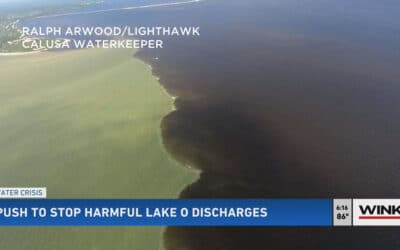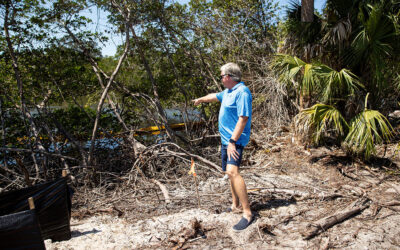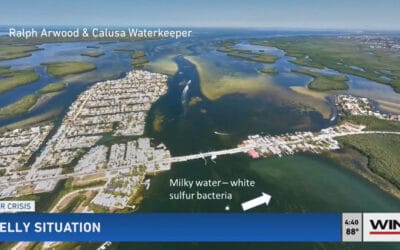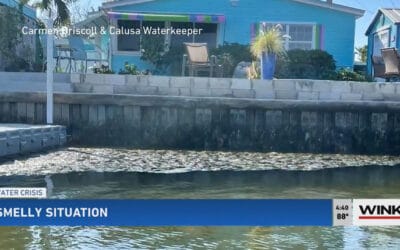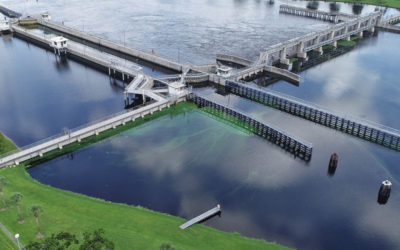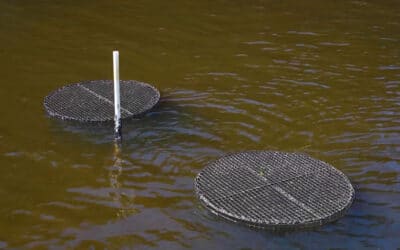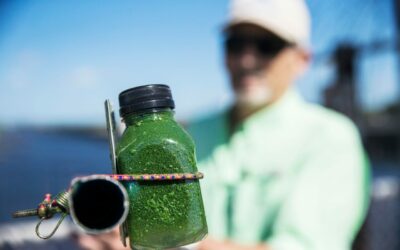Calusa Waterkeeper
In the News
Study Shows Nitrogen Flows Systematically Intensify Red Tide Blooms
A new University of Florida study with two nonprofit research partners shows clear ties between nitrogen from human activities and the longevity and severity of the saltwater harmful algal blooms as published in the academic journal Science of the Total Environment.
Florida Lawmaker Wants to Stop Lake Okeechobee Water Releases
A Florida lawmaker is working to stop harmful discharges that cause blue-green algae in our canals. Representative Brian Mast introduced the Northern Estuaries Restoration Plan Act focusing on ending discharges from Lake O into coastal estuaries.
Calusa Waterkeeper 2022 Annual Meeting and Launch of Collaborative Beer
Calusa Waterkeeper spent a fun night at our annual meeting, debuting a new collaboration with Point Ybel Brewing Co., announcing our slate of board officers, and recognizing individuals who go above and beyond to protect and restore water quality.
Community Collaboration Brews to Benefit Water Quality in Southwest Florida
Local brewery, Point Ybel Brewing Company has launched a collaborative beer, the “Waterkeeper” Hefeweizen. This refreshing brew gives back to our local waterways by donating $1.00 for every pint sold to the local nonprofit, Calusa Waterkeeper.
Mangrove Clearing & Runoff at Siesta Isles near Fort Myers Beach Raises Alarm
As an on-again, off-again project near San Carlos Island moves into its next phase, neighbors are crying foul, and the state environmental agency is promising an inspector’s visit. In progress for more than half a century, work is ramping up again, to the dismay of nearby residents.
Waterborne Documentary Now Available for Free Viewing
Calusa Waterkeeper is thrilled to announce that our latest documentary, Waterborne, is now available FREE for public viewing! This important film, along with our other educational documentaries are all available to view for free on our website.
Calusa Waterkeeper on what to know about Macroalgae at Matlacha
A stench is coming from algae in one part of Southwest Florida. The Calusa Waterkeeper is arming you with what you need to know about this algae. Unsightly, algae is all too common during this time of year. And while the look is one thing, the smell is something completely different.
Calusa Waterkeeper on What to Know About Macroalgae at Matlacha
The Calusa Waterkeeper is arming you with what you need to know about this algae. Unsightly, algae is all too common during this time of year. And while the look is one thing, the smell is something completely different.
Action Alert: Please ask Gov. DeSantis to Veto SB 2508
Join us in asking Florida Governor Ron DeSantis to VETO Senate Bill 2508, which despite various amendments still contains concerning elements harmful to Lake Okeechobee management and several state-wide water quality issues.
DeSantis Urged to Veto Lake Okeechobee Water Supply Bill by Four Environmental Nonprofits
Four South Florida environmental nonprofits sent Gov. Ron DeSantis a letter Wednesday urging him to veto a controversial Lake Okeechobee water supply bill. The governor can sign or veto the bill, but if he does nothing, it becomes law on July 1.
Words from the Waterkeeper, Episode 33
John Cassani brings us up to speed on the latest water quality issues in our region including the monitoring of tapegrass renewal exclosures and the efforts of local organizations to restore this important marine vegetation in the upper estuary of the Caloosahatchee.
Warm Temps Could Fuel Storms this Summer Resulting in Future Algae Blooms
Gulf of Mexico and Lake Okeechobee water temperatures are warm for this time of year, and those warm waters could lead to a myriad of problems, from blue-green algae blooms to feeding tropical storms and hurricanes that could lead to bloom conditions in the summer of 2023.


























